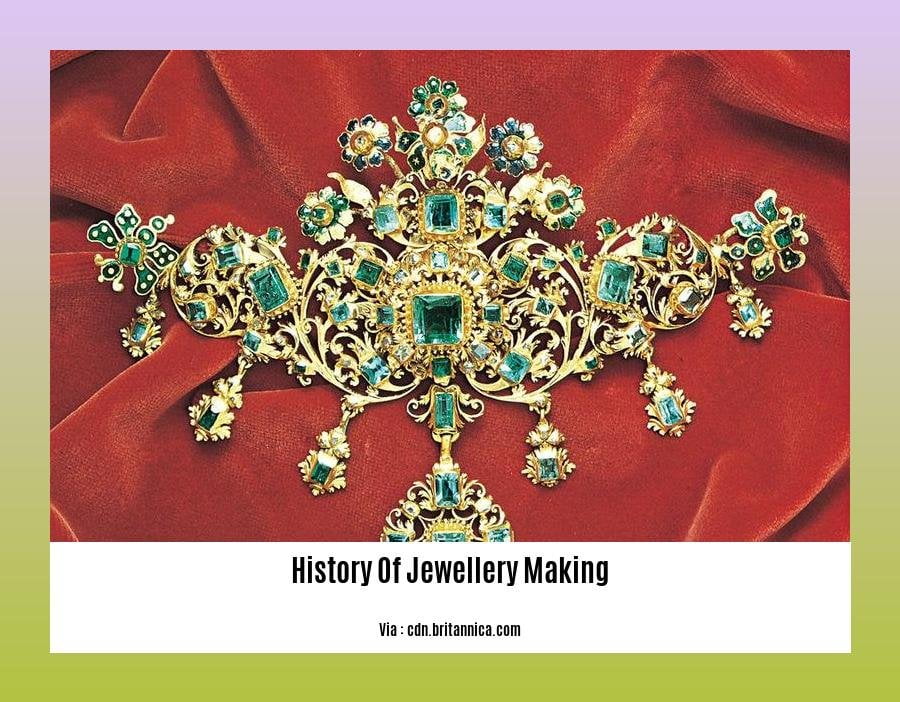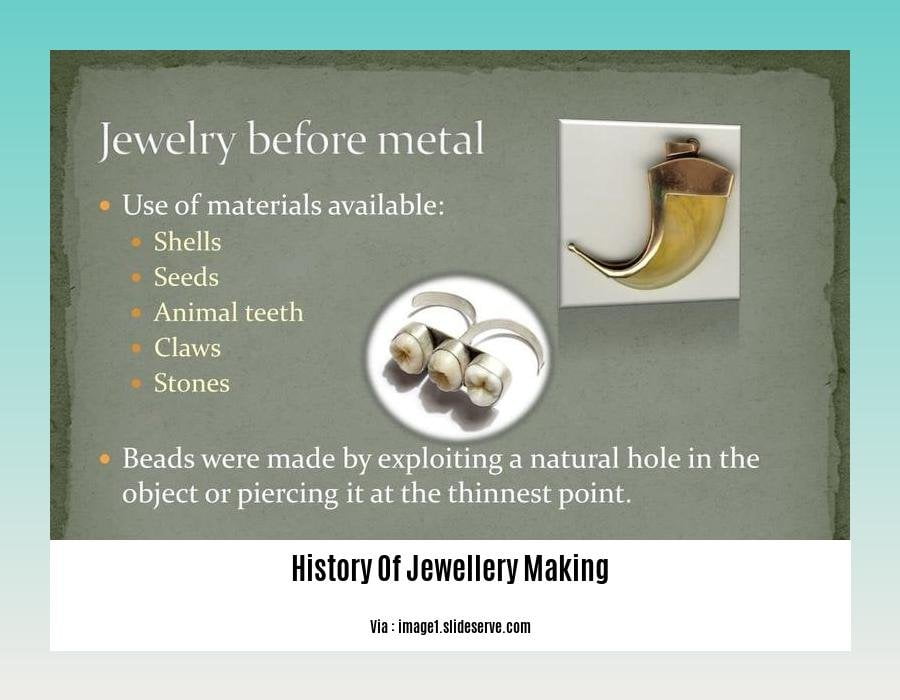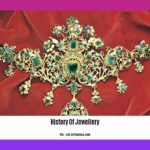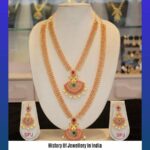Embark on a captivating journey through time and cultures as we unveil the rich history of jewellery making in our article titled [Unveiling the History of Jewellery Making: A Journey Through Time and Cultures]. Discover how jewellery has evolved from ancient adornments to exquisite expressions of art, serving as a mirror reflecting cultural identities, social status, and personal narratives.
Key Takeaways:
Jewellery has a rich history dating back to prehistoric times, with the earliest known pieces originating between 75,000 and 115,000 years ago.
Initially crafted from natural materials like animal parts, shells, pebbles, and feathers, jewellery served practical, spiritual, decorative, and status symbol purposes.
The earliest civilizations to create jewellery from precious metals and gems emerged in the Mediterranean region approximately 3000-4000 BCE.
History of Jewellery Making

Throughout history, the art of crafting jewellery has intertwined with the unfolding narrative of human civilization. From the intricate beads adorning prehistoric garments to the opulent gems that graced the hands of ancient royalty, jewellery has served as a potent symbol of identity, power, and artistry.
The Dawn of Adornment
The earliest evidence of jewellery making dates back to the Upper Paleolithic era, where humans crafted beads from shells, stones, and animal bones. These rudimentary adornments held significant spiritual and practical value, serving as talismans to ward off evil spirits and markers of social status.
The Age of Metals
In the crucible of ancient civilizations, the mastery of metalworking ushered in a new era of jewellery making. Gold, silver, and copper transformed into exquisite ornaments, intricately crafted with techniques like hammering, casting, and filigree. The Egyptians, renowned for their goldsmithing prowess, created elaborate jewellery pieces adorned with precious stones and intricate hieroglyphics.
The Jewels of Antiquity
The Greeks and Romans embraced jewellery as an expression of their cultural and artistic heritage. Greek jewellery, known for its delicate designs and intricate motifs, often incorporated mythological symbols and gemstones. The Romans, influenced by Etruscan craftsmanship, favoured bold, statement pieces that showcased their wealth and status.
The Medieval Masterpieces
During the Middle Ages, jewellery making flourished under the patronage of the Church and the nobility. Goldsmiths created exquisite pieces using a variety of techniques, including enamelling, niello, and granulation. Religious symbols, gemstones, and heraldic motifs adorned rings, necklaces, and brooches, serving as both adornment and symbols of faith and power.
The Renaissance Revival
The Renaissance witnessed a renewed appreciation for classical art and culture, which influenced jewellery design significantly. Goldsmiths drew inspiration from ancient Roman and Greek jewellery, creating pieces that emphasized symmetry, naturalism, and intricate details. Gemstones like diamonds, rubies, and emeralds became increasingly popular, adding a touch of opulence and colour to Renaissance jewellery.
The Baroque and Rococo Era
The Baroque and Rococo periods were characterized by an exuberant and flamboyant style that extended to jewellery design. Bold, asymmetrical pieces with intricate scrollwork, floral motifs, and cascading gemstones were popular. Coloured gemstones, such as sapphires, emeralds, and amethysts, were often used to create striking contrasts and add a sense of drama.
The Victorian Era
The Victorian era ushered in a period of romanticism and sentimentality, which strongly influenced jewellery design. Sentimental pieces, such as lockets and mourning jewellery, became popular, often featuring hair or small portraits of loved ones. Mass production techniques allowed for the creation of more affordable jewellery, making it accessible to a wider range of people.
The Art Nouveau Movement
The Art Nouveau movement, with its emphasis on organic forms and sinuous lines, had a profound impact on jewellery design. Natural motifs, such as flowers, leaves, and insects, were incorporated into jewellery pieces, often crafted from unconventional materials like enamel, glass, and horn.
The Modernist Movement
The Modernist movement in the early 20th century challenged traditional jewellery design conventions. Modernist jewellers experimented with new materials, such as industrial metals and plastics, and simplified forms, rejecting the ornate and excessive styles of the past.
Contemporary Jewellery
Contemporary jewellery continues to push the boundaries of design, with artists using a diverse range of materials, techniques, and concepts to create unique and thought-provoking pieces. Contemporary jewellery often explores themes of identity, politics, and social issues, reflecting the complex and ever-evolving nature of our world.
Intrigued by the history of jewellery? Embark on a journey through time with our comprehensive article exploring the evolution of jewellery design, tracing its origins from ancient civilizations to contemporary trends. history of jewellery design
Learn about the rich history of jewelry in India, with its unique blend of cultural influences, exquisite craftsmanship, and symbolic significance. Discover the stories behind the magnificent pieces that have adorned Indian royalty and commoners alike. history of jewellery in India
Evolution of Design

The evolution of design in jewellery making is a captivating journey that mirrors the ever-changing tapestry of human history and culture. From the simple adornments of prehistoric times to the intricate masterpieces of contemporary artists, jewellery has served as a canvas for creativity, identity, and cultural expression. Let’s embark on this journey through time, exploring the fascinating transformations of jewellery design:
Ancient Origins:
In the dim recesses of the Upper Paleolithic era, humans crafted the earliest known jewellery from shells, bones, and stones, adorning themselves with simple yet evocative talismans.
As civilizations blossomed in the ancient world, precious metals like gold, silver, and bronze took center stage, showcasing the growing mastery of metalworking techniques. Jewellery became a symbol of status, power, and wealth, with intricate designs and gemstones adorning pharaohs, emperors, and other elite figures.
The Renaissance and Beyond:
The Renaissance brought a revival of classical art and culture, infusing jewellery design with naturalism, symmetry, and a celebration of the human form. Cameos, intricate enamel work, and portrait miniatures became popular motifs, reflecting the era’s fascination with individuality and humanism.
The Baroque and Rococo periods ushered in an era of opulence and extravagance, with jewellery becoming a flamboyant display of wealth and status. Elaborate scrollwork, floral motifs, and cascading gemstones characterized the jewellery of this era, capturing the exuberant spirit of the time.
The Victorian Era and Art Nouveau:
The Victorian era brought a shift towards sentimentality and personal expression, with jewellery becoming a tangible reminder of loved ones and special occasions. Lockets, mourning pieces, and sentimental keepsakes became popular, often featuring intricate engravings and personal inscriptions.
Art Nouveau emerged as a reaction to the rigid conventions of the past, embracing organic forms, sinuous lines, and asymmetrical designs. Inspired by nature, Art Nouveau jewellery incorporated motifs of flowers, leaves, and insects, reflecting a desire for a more natural and harmonious aesthetic.
The Modernist Movement and Beyond:
The Modernist movement challenged traditional notions of beauty, embracing industrial metals, geometric forms, and simplified designs. Functionality and minimalism became key principles, as artists sought to create jewellery that was both aesthetically pleasing and practical.
Contemporary jewellery continues to push boundaries, exploring diverse themes and concepts that reflect the complexity of our world. From conceptual pieces that challenge traditional notions of jewellery to wearable sculptures that make a statement, contemporary jewellery is a dynamic and ever-evolving art form.
Key Takeaways:
- Evolution of design in jewellery making has been influenced by cultural, social, and artistic factors throughout history.
- Jewellery has served as a symbol of identity, status, power, and personal expression across different cultures and time periods.
- The use of materials, techniques, and motifs has evolved over time, reflecting the changing aesthetics and values of each era.
- Jewellery design has been inspired by various sources, including nature, art, and cultural traditions.
- Contemporary jewellery continues to challenge and redefine traditional notions of design, embracing diversity and experimentation.
Sources:
Jewelry and culture: A journey through time and cultures
Imagine stepping into a time machine that transports you through the ages, allowing you to witness the evolution of jewelry from humble prehistoric beginnings to the dazzling creations of today. Jewelry has long been an integral part of human culture, intricately intertwined with our history, beliefs, and social interactions. Join us on a captivating journey as we explore how jewelry has served as a mirror reflecting cultural identities across different eras.
The Dawn of Adornment
Our journey starts in the depths of prehistoric times when humans adorned themselves with natural elements like shells, stones, and bones. These early adornments served practical purposes such as protection and warding off evil spirits while also hinting at a desire for beautification. As civilizations blossomed, jewelry evolved into a symbol of status and power.
Ancient Expressions of Identity
In ancient Egypt, jewelry held both religious and symbolic significance. Elaborate necklaces, bracelets, and earrings crafted from gold and gemstones adorned pharaohs and high-ranking officials, representing their divine status. In ancient Rome, jewelry showcased wealth and prestige, with intricate pieces showcasing the empire’s prowess.
Medieval Masterpieces
The Middle Ages witnessed a flourishing of jewelry-making craftsmanship. Goldsmiths employed techniques like enameling, niello, and granulation, creating intricate pieces that reflected the opulence of the era. Jewelry became a symbol of devotion, with crosses and other religious motifs adorning both the clergy and the laity.
Renaissance Refinement
The Renaissance brought a renewed interest in classical art and culture, which influenced jewelry design. Symmetry and naturalism became prominent design elements, with goldsmiths drawing inspiration from ancient Greek and Roman motifs. Jewelry became a symbol of wealth and refinement, reflecting the growing prosperity of the merchant class.
Baroque and Rococo Exuberance
The Baroque and Rococo periods exuded a sense of extravagance and ornamentation. Jewelry reflected this aesthetic, characterized by elaborate scrollwork, floral motifs, and a profusion of gemstones. These pieces symbolized the power and opulence of the aristocracy, who used jewelry to display their wealth and status.
Victorian Sentimentality
The Victorian era brought a shift towards sentimentality and personal expression. Jewelry became a means to commemorate special occasions and honor loved ones. Engraved lockets, mourning jewelry, and sentimental pieces featuring hair or gemstones from deceased loved ones became popular expressions of affection and remembrance.
Art Nouveau’s Organic Elegance
The Art Nouveau movement embraced natural forms and organic motifs, which were reflected in jewelry design. Sinuous lines, flowing forms, and asymmetric designs characterized these pieces, often featuring vibrant gemstones and unconventional materials like enamel and horn. Jewelry became a symbol of individuality and artistic expression.
Modernist Simplicity
The Modernist movement challenged traditional conventions, advocating for simplicity and functionality. Jewelry embraced industrial materials such as steel and concrete, with geometric shapes and clean lines replacing ornate designs. This shift reflected the changing social and cultural landscape of the early 20th century.
Contemporary Diversity
In the contemporary era, jewelry has become a diverse and eclectic realm of expression. Designers draw inspiration from various cultures, historical periods, and artistic movements, creating pieces that reflect the complexity of our world. Jewelry has become a means for personal expression, cultural identity, and artistic experimentation.
Key Takeaways:
Jewelry has been an integral part of human culture since prehistoric times, serving various purposes such as adornment, symbolism, and status.
Ancient civilizations like Egypt and Rome used jewelry to express religious beliefs, social hierarchy, and wealth.
Medieval jewelry showcased intricate craftsmanship and religious iconography, reflecting the piety of the era.
The Renaissance and Baroque periods saw a rise in opulence and ornamentation, with jewelry symbolizing power and prosperity.
The Victorian era brought a sentimental touch to jewelry, with pieces often commemorating special occasions and honoring loved ones.
Art Nouveau embraced organic forms and natural motifs, reflecting the artistic and cultural changes of the late 19th century.
Modernist jewelry challenged conventions, advocating for simplicity and functionality, aligned with the changing social landscape.
Contemporary jewelry is diverse and eclectic, drawing inspiration from various sources and reflecting the complexity of our world.
References:
The History of Jewelry Design: A Timeline
The Evolution of Jewelry: A Timeline
Jewelry as self-expression
Throughout time, civilizations have communicated their sense of self through the art of jewelry. These ornaments have spoken volumes about the wearer’s personality, taste, and treasured memories. Jewelry, with its intricate designs and shimmering stones, has become an extension of the self, a canvas upon which we paint our identities.
Personal Expressions
Jewelry has the unique ability to convey individual stories. A grandmother’s heirloom necklace, passed down through generations, carries sentimental value, reminding us of our family history. An intricately handcrafted ring might symbolize a special bond, a promise between two people. Jewelry becomes a tangible representation of our most cherished moments, a physical expression of our personal narratives.
Cultural Reflections
Just as our individual experiences shape our jewelry choices, so do the cultures in which we live. Traditional jewelry designs, with their distinct motifs and vibrant colors, often reflect a region’s history, beliefs, and artistic traditions. Whether it’s the vibrant beads of an African necklace or the delicate jades of a Chinese pendant, jewelry serves as a visual representation of cultural heritage.
Evolving Trends
The realm of jewelry design is ever-changing, influenced by fashion trends, social movements, and artistic innovations. From the bold geometric patterns of the Art Deco era to the minimalist designs of the modern age, jewelry has evolved to reflect the changing tastes and aspirations of society. These trends, often driven by societal shifts and cultural influences, offer a glimpse into the collective psyche of the times.
Key Takeaways:
- Jewelry is a powerful tool for personal expression, allowing individuals to communicate their identities and values.
- Jewelry carries sentimental value, serving as a reminder of special moments and relationships.
- Traditional jewelry designs reflect the cultural heritage and artistic traditions of a region.
- Jewelry trends evolve in response to changing social movements, artistic innovations, and societal shifts.
Sources:
- Jewelry and Self-Expression: Exploring Individual Style
- Exploring the Role of Jewelry in Personal Expression
FAQ
Q1: What were the earliest known materials used in jewelry making?
A1: In the prehistoric period, people used natural materials such as animal parts, shells, pebbles, and feathers to create jewelry.
Q2: What was the significance of jewelry in ancient civilizations?
A2: In ancient civilizations, jewelry was not merely decorative but held symbolic and religious significance. It was used to denote status, wealth, and affiliation with particular deities or groups.
Q3: How did jewelry designs evolve during different historical periods?
A3: Jewelry designs underwent significant transformations throughout history. In the medieval period, jewelry became more elaborate and ornate, with the use of gemstones and enamel. During the Renaissance, it became more naturalistic and secular, incorporating classical motifs and portraiture. The Baroque period saw a shift towards elaborate and theatrical designs, while the Georgian period favored delicate and refined pieces.
Q4: What role did jewelry play in personal expression and identity?
A4: Throughout history, jewelry has served as a means of self-expression and identity. It allows individuals to communicate their personality, tastes, and values non-verbally, and each piece can hold sentimental or symbolic significance for the wearer.
Q5: How did jewelry-making techniques and materials change over time?
A5: Jewelry-making techniques and materials evolved alongside technological advancements and cultural influences. In early periods, jewelry was crafted using simple tools and natural materials. As civilizations progressed, artisans began using more durable materials such as gold, silver, and bronze, and developed intricate techniques like filigree, granulation, and enameling.
- Senior at What Age: Benefits & Eligibility Guide - March 29, 2025
- Unlocking Senior Benefits: How Old is a Senior? Your Complete Guide - March 29, 2025
- Master Russian Politeness:A Guide to Saying Please - March 29, 2025
















